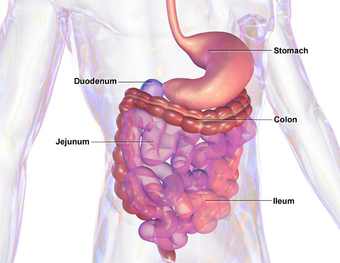Medicine:Cronkhite–Canada syndrome
| Cronkhite–Canada syndrome | |
|---|---|
| Other names | Gastrointestinal polyposis-skin pigmentation-alopecia-fingernail changes syndrome |
 | |
| Cronkhite–Canada syndrome affects the digestive tract | |
Cronkhite–Canada syndrome is a rare syndrome characterized by multiple polyps of the digestive tract. It is sporadic (i.e. it does not seem to be a hereditary disease),[1] and it is currently considered acquired[2] and idiopathic (i.e. cause remains unknown).
About two-thirds of patients are of Japanese descent and the male to female ratio is 3:2.[3] It was characterized in 1955[4][5] by internal medicine physician Leonard Wolsey Cronkhite Jr. and radiologist Wilma Jeanne Canada.[6]
Signs and symptoms
Polyps are found throughout the GI tract (most frequently in the stomach and large intestine, followed by the small intestine) though typically avoid the esophagus.[6] A biopsy will reveal them to be hamartomas; the possibility that they progress to cancer is generally considered to be low,[7] although it has been reported multiple times in the past. Chronic diarrhea and protein-losing enteropathy are often observed. Possible collateral features include variable anomalies of ectodermal tissues, such as alopecia, atrophy of the nails, or skin pigmentation[3]
Causes
The cause of the disease is unknown. It was originally thought that the epidermal changes were secondary to profound malnutrition as a result of protein-losing enteropathy. Recent findings have called this hypothesis into question; specifically, the hair and nail changes may not improve with improved nutrition.[citation needed]
Other conditions consisting of multiple hamartomatous polyps of the digestive tract include Peutz–Jeghers syndrome, juvenile polyposis, and Cowden disease. Related polyposis conditions are familial adenomatous polyposis, attenuated familial adenomatous polyposis, Birt–Hogg–Dubé syndrome and MUTYH.[citation needed]
Diagnosis
There is no specific test to diagnose Cronkhite–Canada syndrome. Diagnosis is based on symptoms and features of the disease.[8]
Management
Nutritional support is fundamental, and may include dietary guidance, supplements, tube feeding, or intravenous solutions.[9] Treatments proposed include cromolyn sodium and prednisone,[10] as well as histamine (H2) receptor antagonists or proton pump inhibitors.[9]
References
- ↑ "Is Cronkhite-Canada Syndrome necessarily a late-onset disease?". Eur J Gastroenterol Hepatol 17 (10): 1139–41. October 2005. doi:10.1097/00042737-200510000-00022. PMID 16148564.
- ↑ "Hamartomatous polyposis syndromes". The Surgical Clinics of North America 88 (4): 779–817, vii. August 2008. doi:10.1016/j.suc.2008.05.002. PMID 18672141.
- ↑ 3.0 3.1 Yuan, Wei; Tian, Li; Ai, Fei-Yan; Liu, Shao-Jun; Shen, Shou-Rong; Wang, Xiao-Yan; Liu, Fen (June 2018). "Cronkhite-Canada syndrome: A case report". Oncology Letters 15 (6): 8447–8453. doi:10.3892/ol.2018.8409. ISSN 1792-1074. PMID 29805581.
- ↑ "Generalized gastrointestinal polyposis; an unusual syndrome of polyposis, pigmentation, alopecia and onychotrophia". N. Engl. J. Med. 252 (24): 1011–5. June 1955. doi:10.1056/NEJM195506162522401. PMID 14383952.
- ↑ "Cronkhite-Canada syndrome". The Ulster Medical Journal 70 (1): 56–8. May 2001. PMID 11428328.
- ↑ 6.0 6.1 Samoha S, Arber N (2005). "Cronkhite-Canada Syndrome". Digestion 71 (4): 199–200. doi:10.1159/000086134. PMID 15942206. https://www.karger.com/Article/PDF/86134.
- ↑ "Adenocarcinoma and multiple adenomas of the large intestine, associated with Cronkhite-Canada syndrome". Dig Liver Dis 35 (6): 434–8. June 2003. doi:10.1016/s1590-8658(03)00160-9. PMID 12868681.
- ↑ "Cronkhite-Canada Syndrome" (in en-US). https://rarediseases.org/rare-diseases/cronkhite-canada-syndrome/.
- ↑ 9.0 9.1 Ward EM, Wolfsen HC (2003). "Pharmacological management of Cronkhite-Canada syndrome". Expert Opin. Pharmacother. 4 (3): 385–389. doi:10.1517/14656566.4.3.385. PMID 12614190.
- ↑ "Medical management of Cronkhite-Canada syndrome". South. Med. J. 95 (2): 272–4. February 2002. doi:10.1097/00007611-200202000-00025. PMID 11846261.
External links
- Rabinowitz, Simon S.; Ebigbo, Nonyelum Erica; Liacouras, C.A.; Puri, K. (2017-10-20). "Pediatric Cronkite-Canada syndrome". http://www.emedicine.com/PED/topic508.htm.
| Classification | |
|---|---|
| External resources |
 |

